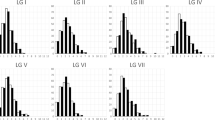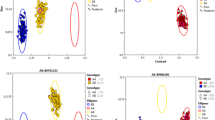Abstract
THE genetical analysis of some of the interchanged lines in Pisum sativum, reported on by Mrs. Sansome above, has given evidence on the distribution of the genes in the normal structural type. In plants of normal structure the genes R (R/r = round/wrinkled cotyledons) and A (A/a = coloured/white flowers) have been exhaustively studied in F2 families from self-fertilization. By this method no clear indication of linkage was found. From back-crosses (453 plants from heterozygous females, and 418 plants from heterozygous males) 47 per cent of crossing-over was obtained1. Hence, in a recent summary of our knowledge of linkage in Pisum, these two genes are placed in different chromosomes2.
This is a preview of subscription content, access via your institution
Access options
Subscribe to this journal
Receive 51 print issues and online access
$199.00 per year
only $3.90 per issue
Buy this article
- Purchase on Springer Link
- Instant access to full article PDF
Prices may be subject to local taxes which are calculated during checkout
Similar content being viewed by others
References
Pellew, C., Z. Zucht. A, Pflanzenzücht., 17, 90 (1931).
Winge, Ö., C.R. Trav. Lab. Carlsb., (Ser. Physiol., 15), 21 (1936).
Sansome, F. W., and E. R., unpublished.
Sansome, E. R., Cytologia, 3, 200 (1932).
Sutton, E., Ann. Bot., 49, 689 (1935).
Author information
Authors and Affiliations
Rights and permissions
About this article
Cite this article
PELLEW, C. Linkage in Structural Hybrids in Pisum sativum. Nature 139, 113–114 (1937). https://doi.org/10.1038/139113b0
Issue Date:
DOI: https://doi.org/10.1038/139113b0
This article is cited by
-
Cytogenetics of the vegetable crops
The Botanical Review (1962)
-
Chromosomal interchanges in plants
The Botanical Review (1956)
-
Genetical studies on the first reciprocal translocation found inPisum sativum
Journal of Genetics (1940)
Comments
By submitting a comment you agree to abide by our Terms and Community Guidelines. If you find something abusive or that does not comply with our terms or guidelines please flag it as inappropriate.



